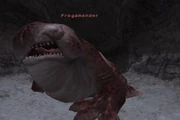No edit summary |
No edit summary |
||
| Line 18: | Line 18: | ||
|align="center"|71-73 |
|align="center"|71-73 |
||
| |
| |
||
| − | *[[Selemnus Belt]] {{Drop Rate| |
+ | *[[Selemnus Belt]] {{Drop Rate|8|136}} |
|align="center"| |
|align="center"| |
||
|align="center"|1 |
|align="center"|1 |
||
Revision as of 20:43, 14 January 2011
|
Job: Notorious Monster |
 Frogamander |
| Zone | Level | Drops | Steal | Spawns | Notes |
|---|---|---|---|---|---|
| Garlaige Citadel | 71-73 | 1 | A, H, HP ~7,000 HP | ||
|
HP = Detects Low HP; M = Detects Magic; Sc = Follows by Scent; T(S) = True-sight; T(H) = True-hearing JA = Detects job abilities; WS = Detects weaponskills; Z(D) = Asleep in Daytime; Z(N) = Asleep at Nighttime; A(R) = Aggressive to Reive participants | |||||
Notes:
- 2-hour timed spawn at dead-end at (H-8) behind Banishing Gate #2, near the coffer spot there.
- Attacks have En-Paralyze. Not 100%. When it does land, it does not have a long duration.
- Highly resistant, if not immune to Gravity, Bind and Sleep.
- Susceptible to Paralyze and Blind.
- Favors Whip Tongue over other TP moves.
- Does NOT seem to have Regain. Used TP moves very infrequently solo.
- Hard to kite very far. Loses hate easily, but will return to spawn point very slowly, about 1 square every 5 minutes or so.
- soloable by many jobs with Ninja sub, at 75 by certain jobs with preparation. Easy duo. (see testimonials)
Background
The word frogamander was coined by University of Calgary comparative biologist, Jason Anderson, to describe a fossil thought to show an evolutionary link between frogs and salamanders. The fossil is 290 million years old and was found in Texas in 1995 by a field study group associated with the Smithsonian Institution. The discovery of the frogamander fossil suggests that frogs and salamanders share an ancestor.
The frogamander fossil shows a skull that resembles a frog's, but fused ankle bones that only salamanders have. The backbone is said to reflect a combination of a frog and a salamander spine. The frogamander fossil shows that the creature died on its back. The 290 million year old fossil provides evidence of the long disputed missing link between extinct and modern frogs and salamanders.
Anderson named the frogamander fossil, Gerobatrachus hottoni after one of the Smithsonian field group members that found the fossil in 1995 in Texas. The name means Hotton's elderly frog. Anderson notes that the fossil was in Nicholas Hotton's pocket with a piece of paper containing the word, Froggie on it. According to Anderson, the note indicates that Hotton did understand what the fossil actually was.
Anderson's team at the Faculty of Veterinary Medicine at the University of Calgary in Alberta, Canada, took many hours to remove layers of rocks to reveal the entire skeleton. This was done years after the 1995 discovery and Anderson and his team were the first to work on the frogamander fossil. The fossil turned out to be nearly complete in its visible impression of the frogamander creature.
One ongoing argument in the scientific community was that modern salamanders and frogs did not evolve from an ancient amphibian species. The discovery of the 290 million year old frogamander fossil has put that argument to rest. Thanks to the proven existence of Gerobatrachus hottoni, we now know that some modern salamanders and frogs evolved from the ancient amphibian group, temnospondyls.
